A Pair of Intel Xeon X5570 Gainestown CPUs
Intel has officially announced the Xeon processor 5500 series, previously codenamed "Nehalem-EP," which is the server version of the the Intel Core i7 desktop processor. These new LGA1366 server processors that are derived from the Nehalem microarchitecture and are officially known to be Gainestown cores. These SMP-enabled parts feature a second 6.4GT/s QPI link to broker inter-CPU communication, which is the main difference between them and desktop parts. As far as specs are concerned, the processors support tri-channel DDR3, 4MB or 8MB L3 cache, and an 80-130W TDP. The Intel Xeon processor 5500 series includes many of the same breakthrough technologies that radically improved system speed when the Core i7 desktop processor was launched. Technologies such as Intel Turbo Boost Technology, Intel Hyper-Threading Technology, integrated power gates, and Next-Generation Intel Virtualization Technology (VT) improved through extended page tables, allow the system to adapt to a broad range of workloads.

Intel does not have just one or two of these processors coming out, they have ten Gainestown processors that are on the way to retail markets around the world. When it comes to pricing the Intel Xeon processor 5500 series ranges in price from $188 to $1,600 in quantities of 1,000. Major computer makers, such as Hewlett-Packard, Dell, and IBM will feature them in servers soon, if they have not already.
130W TDP / DDR3-1333:
- Xeon W5580
95W TDP / DDR3-1333:
- Xeon X5570
- Xeon X5560
- Xeon X5550
80W TDP / DDR3-1066:
- Xeon E5540
- Xeon E5530
- Xeon E5520
80W TDP / DDR3-800:
- Xeon E5506
- Xeon E5504
80W TDP / DDR3-800 / Dual Core:
- Xeon E5502
The Intel Xeon W5580 (BX80602W5580) is the fastest of the Gainestown processors as it operates at 3.20GHz with 8MB of L3 shared cache and a TDP of 130W. Due to this the processor has an MSRP right around $1600 USD each! While I would have loved to get my hands on a pair of Xeon W5580 processors, I was able to get a pair of Intel Xeon X5570 processors to benchmark!
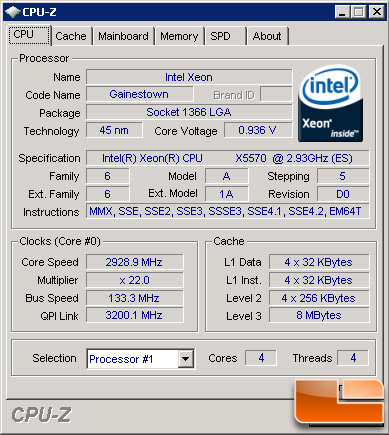
With a clock frequency of 2.93GHz the Intel Xeon X5570 is still a force to be reckoned with and as you can see from the CPU-Z shot above. According to the CPU-Z readings and from what I could tell in the BIOS this 95W TDP processor runs at idle with 0.936V and at full load at 1.104V. These are awesome voltage numbers that are being seen from a recent D0 stepping processor. With a full 8MB of L3 shared cache and a 6.4GT/s QPI link this processor should destroy any other processor that we have ever benchmarked here on Legit Reviews. It should be noted that on the Intel Xeon X5570 the processor operates at 2.93GHz with DDR3 memory speeds up to 1333MHz. Under certain conditions, Intel Turbo Boost Technology can provide operating frequencies up to 3.33 GHz, depending on the processor and system configuration. Let's take a look at Cinebench R10 and find out! I'll also be including the performance results of a pair of Intel Xeon E5520 Gainestown processors that operate at 2.26GHz with a full 8MB of shared L3 cache, but a lower QPI of just 5.86GT/s. Thanks to the lower QPI speed the DDR memory can only run at 1066MHz.
Cinebench R10
MAXON; CINEBENCH R10:
CINEBENCH is the free benchmarking tool for Windows and Mac OS based on the powerful 3D software CINEMA 4D. Consequently, the results of tests conducted using CINEBENCH 10 carry significant weight when analyzing a computer's performance in everyday use. Especially a system's CPU and the OpenGL capabilities of its graphics card are put through their paces (even multiprocessor systems with up to 16 dedicated CPUs or processor cores). The test procedure consists of two main components: The first test sequence is dedicated to the computer's main processor. A 3D scene file is used to render a photo realistic image. The scene makes use of various CPU-intensive features such as reflection, ambient occlusion, area lights and procedural shaders. In the first run, the benchmark only uses one CPU (or CPU core), to ascertain a reference value. On machines that have multiple CPUs or CPU cores, and also on those who simulate multiple CPUs (via HyperThreading or similar technologies), MAXON CINEBENCH will run a second test using all available CPU power. Again, higher Frames/Second and lower rendering time in seconds equal better performance.

Cinebench R10 was able to put a 100% load across all the cores on all of the physical and logical cores, which makes this a great benchmark to look at multi-core platforms.

Lavalys Everest
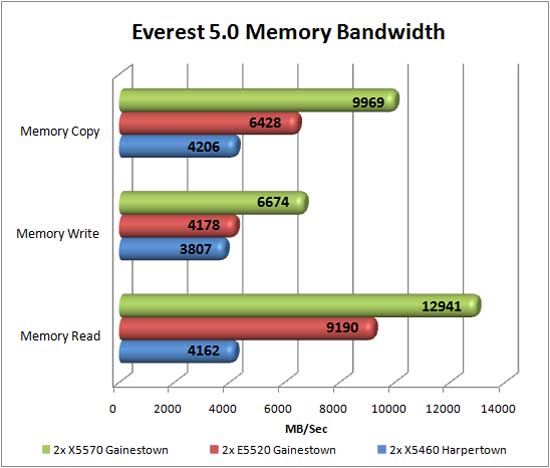
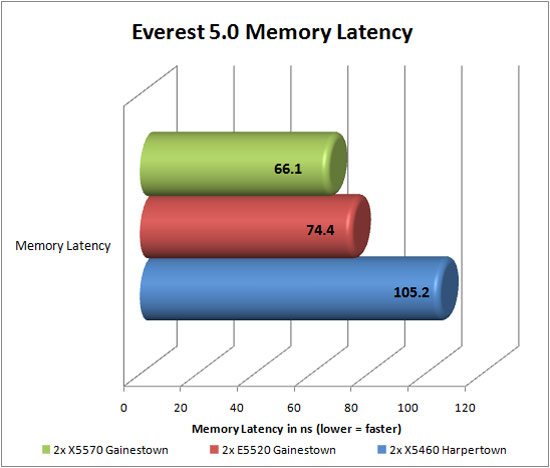
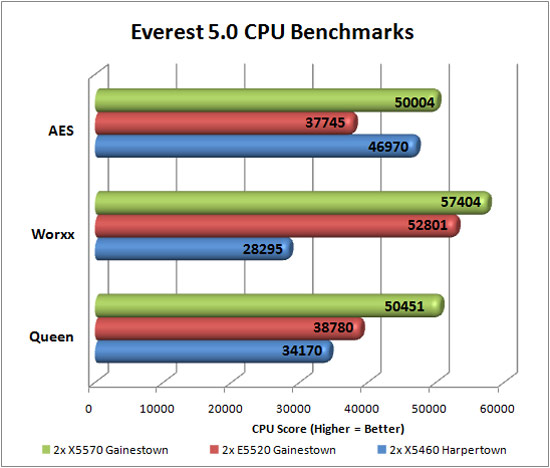
Benchmark Results: This CPU Queen benchmark is simple integer benchmark focuses on the branch prediction capabilities and the misprediction penalties of the CPU. It finds the solutions for the classic "Queens problem" on a 10 by 10 sized chessboard (see the source of the benchmark). The new Nehalem based Intel Xeon 5500 series processors do great on this benchmark as well as the Worxx CPU benchmark. Some strange results were observed in the AES benchmark though. The AES benchmark is an integer benchmark that measures CPU performance using AES (a.k.a. Rijndael) data encryption. It utilizes Vincent Rijmen, Antoon Bosselaers and Paulo Barreto's public domain C code in ECB mode (check the code out here). It seems that Harpertown does a great job with AES data encryption and was actually faster than the pair of E5520 Gainestown processors.
wPrime and Conclusion
wPrime is a benchmarking application designed to use a highly multithreaded approach to calculating the square-roots of large amounts of numbers (up to 32 billion at this stage!). I ran both the Intel Xeon E5520 and X5570 processors on wPrime Benchmark v1.55 to see how each set of processors do on the 32M speed test and the 1024M stability test.
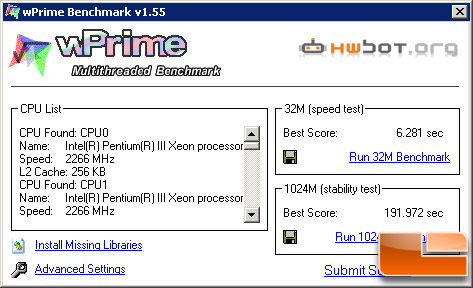
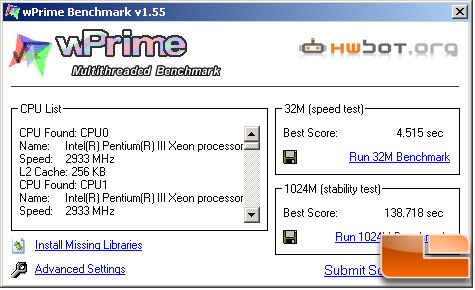
Final Thoughts and Conclusions:
Our quick look at the Intel Xeon 5500 series was a very impressive one. The Intel Xeon X5570 that we looked at today operates at 2.93GHz during normal operation, but when Turbo Boost Technology is enabled the operating frequencies increased up to 3.33GHz. With this much clock frequency and all the performance features that the Intel Xeon 5500 series has to offer you end up with a server processor that blows past the competition without looking back.
When it comes to pricing the Intel Xeon E5520 can be purchased for $394.99 shipped, while the Intel Xeon X5570 can be found for $1448.99 (It has a suggested retail price of $1386). With many IT departments having shrinking budgets this year these will be a tough sell for many companies, but for those with a budget they are able to spend these processors will increase productivity in the server room!
Legit Bottom Line: The Intel Xeon E5520 and X5570 server processors proved to be much faster than Harpertown and will boost productivity for server applications.
Source :http://www.legitreviews.com/article/943/4/
writer : Nathan Kirsch - nate@legitreviews.com
OK, you stolen this article from www.legitreviews.com, now what?
BalasHapus